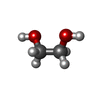[English] 日本語
 Yorodumi
Yorodumi- PDB-4ole: Crystal structure of a neighbor of BRCA1 gene 1 (NBR1) from Homo ... -
+ Open data
Open data
- Basic information
Basic information
| Entry | Database: PDB / ID: 4ole | ||||||
|---|---|---|---|---|---|---|---|
| Title | Crystal structure of a neighbor of BRCA1 gene 1 (NBR1) from Homo sapiens at 2.52 A resolution | ||||||
 Components Components | Next to BRCA1 gene 1 protein | ||||||
 Keywords Keywords | STRUCTURAL GENOMICS / UNKNOWN FUNCTION / Ig-like domain from next to BRCA1 gene / PF16158 family / Joint Center for Structural Genomics / JCSG / Protein Structure Initiative / PSI-BIOLOGY | ||||||
| Function / homology |  Function and homology information Function and homology informationregulation of bone mineralization / phagophore assembly site / M band / peroxisomal membrane / mitogen-activated protein kinase binding / regulation of stress-activated MAPK cascade / negative regulation of osteoblast differentiation / Pexophagy / autophagosome / ubiquitin binding ...regulation of bone mineralization / phagophore assembly site / M band / peroxisomal membrane / mitogen-activated protein kinase binding / regulation of stress-activated MAPK cascade / negative regulation of osteoblast differentiation / Pexophagy / autophagosome / ubiquitin binding / macroautophagy / mitochondrial intermembrane space / late endosome / lysosome / receptor complex / nuclear body / intracellular membrane-bounded organelle / zinc ion binding / nucleoplasm / membrane / cytosol Similarity search - Function | ||||||
| Biological species |  Homo sapiens (human) Homo sapiens (human) | ||||||
| Method |  X-RAY DIFFRACTION / X-RAY DIFFRACTION /  SYNCHROTRON / SYNCHROTRON /  MAD / Resolution: 2.52 Å MAD / Resolution: 2.52 Å | ||||||
 Authors Authors | Joint Center for Structural Genomics (JCSG) | ||||||
 Citation Citation |  Journal: To be published Journal: To be publishedTitle: Crystal structure of a neighbor of BRCA1 gene 1 (NBR1) from Homo sapiens at 2.52 A resolution Authors: Joint Center for Structural Genomics (JCSG) | ||||||
| History |
|
- Structure visualization
Structure visualization
| Structure viewer | Molecule:  Molmil Molmil Jmol/JSmol Jmol/JSmol |
|---|
- Downloads & links
Downloads & links
- Download
Download
| PDBx/mmCIF format |  4ole.cif.gz 4ole.cif.gz | 227.1 KB | Display |  PDBx/mmCIF format PDBx/mmCIF format |
|---|---|---|---|---|
| PDB format |  pdb4ole.ent.gz pdb4ole.ent.gz | 183.8 KB | Display |  PDB format PDB format |
| PDBx/mmJSON format |  4ole.json.gz 4ole.json.gz | Tree view |  PDBx/mmJSON format PDBx/mmJSON format | |
| Others |  Other downloads Other downloads |
-Validation report
| Summary document |  4ole_validation.pdf.gz 4ole_validation.pdf.gz | 466.6 KB | Display |  wwPDB validaton report wwPDB validaton report |
|---|---|---|---|---|
| Full document |  4ole_full_validation.pdf.gz 4ole_full_validation.pdf.gz | 467.7 KB | Display | |
| Data in XML |  4ole_validation.xml.gz 4ole_validation.xml.gz | 26.5 KB | Display | |
| Data in CIF |  4ole_validation.cif.gz 4ole_validation.cif.gz | 39.4 KB | Display | |
| Arichive directory |  https://data.pdbj.org/pub/pdb/validation_reports/ol/4ole https://data.pdbj.org/pub/pdb/validation_reports/ol/4ole ftp://data.pdbj.org/pub/pdb/validation_reports/ol/4ole ftp://data.pdbj.org/pub/pdb/validation_reports/ol/4ole | HTTPS FTP |
-Related structure data
| Similar structure data | |
|---|---|
| Other databases |
- Links
Links
- Assembly
Assembly
| Deposited unit | 
| ||||||||
|---|---|---|---|---|---|---|---|---|---|
| 1 | 
| ||||||||
| 2 | 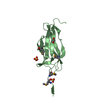
| ||||||||
| 3 | 
| ||||||||
| 4 | 
| ||||||||
| 5 | 
| ||||||||
| Unit cell |
|
- Components
Components
| #1: Protein | Mass: 13772.229 Da / Num. of mol.: 4 / Fragment: UNP residues 365-485 Source method: isolated from a genetically manipulated source Source: (gene. exp.)  Homo sapiens (human) / Gene: 1A13B, BC009808, KIAA0049, M17S2, MIG19, NBR1 / Plasmid: SpeedET / Production host: Homo sapiens (human) / Gene: 1A13B, BC009808, KIAA0049, M17S2, MIG19, NBR1 / Plasmid: SpeedET / Production host:  #2: Chemical | ChemComp-SO4 / #3: Chemical | ChemComp-EDO / #4: Water | ChemComp-HOH / | Has protein modification | Y | Sequence details | THE CONSTRUCT (365-485) WAS EXPRESSED WITH A PURIFICATION TAG MGSDKIHHHHHHENLYFQG. THE TAG WAS ...THE CONSTRUCT (365-485) WAS EXPRESSED WITH A PURIFICATI | |
|---|
-Experimental details
-Experiment
| Experiment | Method:  X-RAY DIFFRACTION / Number of used crystals: 1 X-RAY DIFFRACTION / Number of used crystals: 1 |
|---|
- Sample preparation
Sample preparation
| Crystal | Density Matthews: 6.5 Å3/Da / Density % sol: 81.08 % |
|---|---|
| Crystal grow | Temperature: 277 K / Method: vapor diffusion, sitting drop / pH: 8.33 Details: 2.35M ammonium sulfate, 0.1M TRIS pH 8.33, 0.01M Adenosine-5'-triphosphate disodium salt hydrate, NANODROP, VAPOR DIFFUSION, SITTING DROP, temperature 277K |
-Data collection
| Diffraction | Mean temperature: 100 K | |||||||||||||||||||||||||||||||||||||||||||||||||||||||||||||||||||||||||||||
|---|---|---|---|---|---|---|---|---|---|---|---|---|---|---|---|---|---|---|---|---|---|---|---|---|---|---|---|---|---|---|---|---|---|---|---|---|---|---|---|---|---|---|---|---|---|---|---|---|---|---|---|---|---|---|---|---|---|---|---|---|---|---|---|---|---|---|---|---|---|---|---|---|---|---|---|---|---|---|
| Diffraction source | Source:  SYNCHROTRON / Site: SYNCHROTRON / Site:  SSRL SSRL  / Beamline: BL11-1 / Wavelength: 0.97891,0.97949,0.91837 / Beamline: BL11-1 / Wavelength: 0.97891,0.97949,0.91837 | |||||||||||||||||||||||||||||||||||||||||||||||||||||||||||||||||||||||||||||
| Detector | Type: DECTRIS PILATUS 6M / Detector: PIXEL / Date: Nov 27, 2013 Details: Flat mirror (vertical focusing); single crystal Si(111) bent monochromator (horizontal focusing) | |||||||||||||||||||||||||||||||||||||||||||||||||||||||||||||||||||||||||||||
| Radiation | Monochromator: single crystal Si(111) bent / Protocol: MAD / Monochromatic (M) / Laue (L): M / Scattering type: x-ray | |||||||||||||||||||||||||||||||||||||||||||||||||||||||||||||||||||||||||||||
| Radiation wavelength |
| |||||||||||||||||||||||||||||||||||||||||||||||||||||||||||||||||||||||||||||
| Reflection | Resolution: 2.52→48.72 Å / Num. obs: 50067 / % possible obs: 99.9 % / Observed criterion σ(I): -3 / Redundancy: 8.76 % / Biso Wilson estimate: 61.165 Å2 / Rmerge(I) obs: 0.122 / Net I/σ(I): 15.26 | |||||||||||||||||||||||||||||||||||||||||||||||||||||||||||||||||||||||||||||
| Reflection shell | Diffraction-ID: 1
|
-Phasing
| Phasing | Method:  MAD MAD |
|---|
- Processing
Processing
| Software |
| |||||||||||||||||||||||||||||||||||||||||||||||||||||||||||||||||||||||||||||||||||||||||||||||||||||||||||||||||||||||||||||
|---|---|---|---|---|---|---|---|---|---|---|---|---|---|---|---|---|---|---|---|---|---|---|---|---|---|---|---|---|---|---|---|---|---|---|---|---|---|---|---|---|---|---|---|---|---|---|---|---|---|---|---|---|---|---|---|---|---|---|---|---|---|---|---|---|---|---|---|---|---|---|---|---|---|---|---|---|---|---|---|---|---|---|---|---|---|---|---|---|---|---|---|---|---|---|---|---|---|---|---|---|---|---|---|---|---|---|---|---|---|---|---|---|---|---|---|---|---|---|---|---|---|---|---|---|---|---|
| Refinement | Method to determine structure:  MAD / Resolution: 2.52→48.72 Å / Cor.coef. Fo:Fc: 0.9329 / Cor.coef. Fo:Fc free: 0.9389 / Occupancy max: 1 / Occupancy min: 0.35 / Cross valid method: THROUGHOUT / σ(F): 0 MAD / Resolution: 2.52→48.72 Å / Cor.coef. Fo:Fc: 0.9329 / Cor.coef. Fo:Fc free: 0.9389 / Occupancy max: 1 / Occupancy min: 0.35 / Cross valid method: THROUGHOUT / σ(F): 0 Details: 1. A MET-INHIBITION PROTOCOL WAS USED FOR SELENOMETHIONINE INCORPORATION DURING PROTEIN EXPRESSION. THE OCCUPANCY OF THE SE ATOMS IN THE MSE RESIDUES WAS REDUCED TO 0.75 FOR THE REDUCED ...Details: 1. A MET-INHIBITION PROTOCOL WAS USED FOR SELENOMETHIONINE INCORPORATION DURING PROTEIN EXPRESSION. THE OCCUPANCY OF THE SE ATOMS IN THE MSE RESIDUES WAS REDUCED TO 0.75 FOR THE REDUCED SCATTERING POWER DUE TO PARTIAL S-MET INCORPORATION. 2. ATOM RECORD CONTAINS SUM OF TLS AND RESIDUAL B FACTORS. ANISOU RECORD CONTAINS SUM OF TLS AND RESIDUAL U FACTORS. 3. THE MAD PHASES WERE USED AS RESTRAINTS DURING REFINEMENT. 4. NCS RESTRAINTS WERE APPLIED USING BUSTER'S LSSR RESTRAINT REPRESENTATION (-AUTONCS). 5. SULFATE (SO4) AND ETHYLENE GLYCOL (EDO) MODELED WERE PRESENT IN CRYSTALLIZATION/CRYO CONDITIONS.
| |||||||||||||||||||||||||||||||||||||||||||||||||||||||||||||||||||||||||||||||||||||||||||||||||||||||||||||||||||||||||||||
| Displacement parameters | Biso max: 165.53 Å2 / Biso mean: 51.4814 Å2 / Biso min: 24.32 Å2
| |||||||||||||||||||||||||||||||||||||||||||||||||||||||||||||||||||||||||||||||||||||||||||||||||||||||||||||||||||||||||||||
| Refine analyze | Luzzati coordinate error obs: 0.28 Å | |||||||||||||||||||||||||||||||||||||||||||||||||||||||||||||||||||||||||||||||||||||||||||||||||||||||||||||||||||||||||||||
| Refinement step | Cycle: LAST / Resolution: 2.52→48.72 Å
| |||||||||||||||||||||||||||||||||||||||||||||||||||||||||||||||||||||||||||||||||||||||||||||||||||||||||||||||||||||||||||||
| Refine LS restraints |
| |||||||||||||||||||||||||||||||||||||||||||||||||||||||||||||||||||||||||||||||||||||||||||||||||||||||||||||||||||||||||||||
| LS refinement shell | Resolution: 2.52→2.58 Å / Total num. of bins used: 20
| |||||||||||||||||||||||||||||||||||||||||||||||||||||||||||||||||||||||||||||||||||||||||||||||||||||||||||||||||||||||||||||
| Refinement TLS params. | Method: refined / Refine-ID: X-RAY DIFFRACTION
| |||||||||||||||||||||||||||||||||||||||||||||||||||||||||||||||||||||||||||||||||||||||||||||||||||||||||||||||||||||||||||||
| Refinement TLS group |
|
 Movie
Movie Controller
Controller


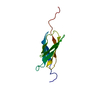
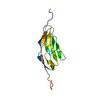

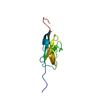



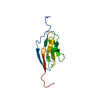
 PDBj
PDBj







